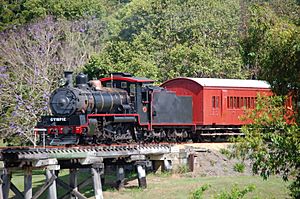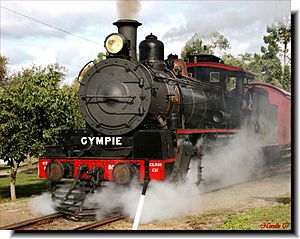Mary Valley Rattler facts for kids
The Mary Valley Rattler is a special heritage railway line in Queensland, Australia. It takes people on fun steam train trips through the beautiful Mary Valley, starting from Gympie. This railway is a big tourist attraction and is run by a group that doesn't aim to make a profit. Some people even say it's Australia's third-biggest heritage railway!
The railway had to close in 2012 because of safety worries. But in 2016, the Gympie Regional Council gave money to fix it up, knowing how important it was for tourism. The train rides started again between Gympie and Amamoor on 6 October 2018.
Contents
A Look Back at the Railway's History
The Mary Valley railway line was a smaller line that connected to the main North Coast railway line. It started near Gympie and went west into the Mary Valley, ending at Brooloo. It was built between 1911 and 1915. The idea was to help more people settle and farm in the Mary River valley. The line reached Kandanga in February 1914 and Brooloo in April 1915. There were plans to extend it further to Kenilworth, but this never happened.
By the 1970s, the railway started losing money. This was partly because people were buying less butter, and Australia lost its export market to the UK when the UK joined the European Economic Community. The big butter factory in Gympie, which was once Australia's largest, closed in 1978. Over time, staff were removed from stations like Imbil, Amamoor, and Dagun. Some railway buildings were even sold.
However, the pineapple industry in the area fought to keep the line open until 1995. Then, in 1996, a group called the Mary Valley Heritage Railway Board suggested running a tourist train. Volunteers and trainees would help run it. The tourist train service officially began on 23 May 1998.
In 2010, a review found that the railway was losing a lot of money and depended on grants. In 2011, there were some safety concerns, but inspectors didn't find major problems. During the 2010-11 Queensland floods, when roads were closed, the railway even helped by running shuttle services.
Sadly, after two serious train accidents in August and September 2012, the railway was declared unsafe. The Department Transport & Main Roads shut it down. After more flood damage in 2013, the railway group broke up. But in June 2016, the Gympie Regional Council stepped in. They gave $250,000 to help start it up again and $3.8 million for repairs. This allowed the Mary Valley Rattler to get back on track!
Riding the Rattler: Tours and Journeys
The "Ride The Rattler" scenic tours are a popular way to explore the Mary Valley. These trips usually run on Saturdays, Sundays, and Wednesdays. They start from the historic Gympie Railway Station.
The journey is about 40 kilometers long. It begins in Gympie, crosses the Mary River, and then winds through many curves, hills, and bridges. You'll pass through charming country villages like Dagun, Amamoor, and Kandanga.
The train is a fully restored C17 class steam locomotive, which means it's a classic train from the early 1920s. It leaves Gympie station at 10 am. The Gympie Station building itself is very old, dating back to before 1880!
As the train leaves Gympie, it enters the beautiful Mary Valley. The line moves away from the main river to follow smaller creeks like Yabba, Kandanga, and Amamoor Creeks. This part of the journey has lots of twists, turns, and bridges as you head towards Kandanga station.
The village of Kandanga was set up in 1910 because of the railway. The Kandanga railway station, which has been beautifully restored, has interesting pictures showing the history of the Mary Valley line.
Further along, heading towards Imbil, the train goes through a cool gorge with lots of trees. It even passes through a short tunnel that cuts through a ridge of coastal mountains. After that, the track quickly goes downhill to Imbil, which is the biggest town on the line. The Imbil Railway Bridge, which crosses Yabba Creek, was built between 1911 and 1915.
The Rattler's Train Collection
The Mary Valley Rattler has a collection of different trains, including steam locomotives and diesel locomotives. Some are ready to go, while others are being fixed up.
Steam Locomotives
| Number | Year built | Builder | Status | Notes | Colours | ||||||||||||||||||||||||||||||||||||||||||
|---|---|---|---|---|---|---|---|---|---|---|---|---|---|---|---|---|---|---|---|---|---|---|---|---|---|---|---|---|---|---|---|---|---|---|---|---|---|---|---|---|---|---|---|---|---|---|---|
| C17 45 | 1923 | Evans Anderson Phelan, Brisbane. | Stored | Used to run from 1996 to 2003, now kept at Gympie. | QR Black and Red | ||||||||||||||||||||||||||||||||||||||||||
| C17 253 | 1921 | Evans Anderson Phelan, Brisbane. | Being Fixed | Was at Mundubbera, traded for another train in 2003. | *dismantled | ||||||||||||||||||||||||||||||||||||||||||
| C17 705 | 1926 | Evans Anderson Phelan, Brisbane. | Stored | Was on display at a preschool until 2009 when it was bought. | Apple Green and Red | ||||||||||||||||||||||||||||||||||||||||||
| C17 819 | 1927 | Armstrong Whitworth, Newcastle upon Tyne. | Being Fixed | Was on display at Cloncurry until bought in the 1990s. | *dismantled | ||||||||||||||||||||||||||||||||||||||||||
| C17 967 | 1950 | Walkers Limited, Maryborough. | Running | This is the main train running now. It was once on display in a park. | QR Black and Red | ||||||||||||||||||||||||||||||||||||||||||
| C17 996 | 1953 | Walkers Limited, Maryborough. | Stored/Spare parts | Was on display at Southport. Bought for parts to help fix C17 967. | }
Past Steam Locomotives
Diesel Locomotives
Special Heritage PlacesThe Mary Valley Rattler has several places that are "heritage-listed." This means they are important historical sites that are protected. These include:
See also
|



